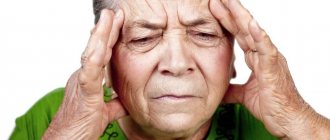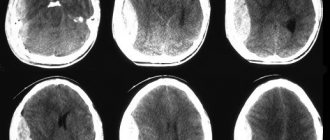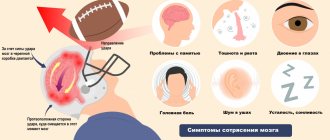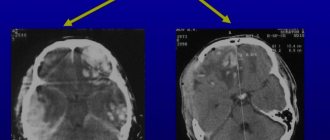Sometimes states arise when clear consciousness, due to the action of certain factors, becomes clouded and narrowed. In such a twilight state of consciousness, a person can commit socially dangerous actions and cause irreparable harm to objects and people. This disorder of consciousness is difficult because it arises and disappears suddenly, without any prerequisites or consequences for the person himself.
Twilight stupefaction - what is it and how does it manifest?
A twilight state of consciousness is a mental state with deep disorientation, limitation of consciousness on certain objects or persons, accompanied by psychomotor restlessness and aggression.
An episode of twilight disorder of consciousness is subsequently replaced by complete amnesia; the person cannot remember how he behaved, what happened around him during the narrowing of consciousness.
In clinical practice, there are often cases when a person unknowingly leaves for another city or region. He subsequently describes his state as follows: “Sitting on the bus, I seemed to think or close my eyes for a few seconds... I didn’t understand how I ended up in a place unfamiliar to me. I asked a passerby, it turned out I was in another city...” However, not in all cases this violation is harmless; a person can unknowingly seriously injure or kill, and with frantic cruelty.
Twilight disorder of consciousness refers to disorders of higher mental processes. With the help of consciousness, a person learns about the world around him, himself, and adapts to changing environmental conditions.
Being in a clear consciousness, a person easily relates himself and the surrounding reality, soberly assesses his capabilities. In this case, they say that he is correctly oriented in location, time, surrounding situation and his own personality.
Chapter III. DISORDERS OF CONSCIOUSNESS
Disturbances of consciousness are among the least developed issues. Despite the fact that all psychiatry textbooks describe various forms of disturbance of consciousness, the definition of this concept encounters difficulties. This happens because the concept of consciousness in psychiatry is not based on a philosophical and psychological interpretation.
Consciousness can be considered in different aspects. In philosophy, it has a broad meaning, being used in terms of contrasting the ideal with the material (as secondary to the primary), from the point of view of origin (a property of highly organized matter), from the point of view of reflection (as reflecting the objective world).
In a narrower sense, consciousness is a human reflection of existence, a reflection in socially developed forms of the ideal. Marxism associates the emergence of human consciousness with the emergence of labor in the process of transformation of a monkey into man. The impact on nature in the course of collective work activity gave rise to an awareness of the properties and natural connections of phenomena, which was consolidated in the language formed in the process of communication. In work and real communication, self-awareness arose - awareness of one’s own relationship to the natural and social environment, an understanding of one’s place in the system of social relations. The specificity of the human reflection of existence is that “human consciousness not only reflects the objective world, but also creates it” [1, 29, 194].
When solving the problem of consciousness in psychology, Soviet scientists proceed from the provisions of Marxist-Leninist philosophy. Consciousness is considered as the highest function of the brain associated with speech, reflecting reality in a generalized form and purposefully regulating human activity.
S. L. Rubinstein paid much attention to the problem of consciousness in psychology [159; 160]. Saying that consciousness is the process of the subject’s awareness of the objective existence of reality, he emphasized that consciousness is the knowledge of how an object opposes the knowing subject. The problem of the connection between consciousness and activity is also given attention in the works of A. N. Leontyev. He directly points out that consciousness can be understood “as a subjective product, as a transformed form of manifestation of those relations that are social in nature, which are carried out by human activity in the objective world... It is not the image that is imprinted in the product, but precisely the activity - the objective content that it objectively carries in yourself" [113, 130].
Consciousness includes not only knowledge about the world around us, but also knowledge about oneself - about one’s individual and personal properties (the latter presupposes awareness of oneself in the system of social relations). In contrast to the traditional use of the concept of “self-awareness,” A. N. Leontyev proposes to use this term in the sense of awareness of one’s personal qualities. He says that self-consciousness, the consciousness of one’s “I,” is awareness in the system of social relations and does not represent anything else.
The problem of self-awareness is given a lot of research (S. L. Rubinshtein, B. G. Ananyev, L. I. Bozhovich, etc.), analysis of its methodological aspect (I. I. Chesnokova, E. V. Shorokhova), the connection of self-awareness with cognition other people (A. A. Bodalev, I. S. Kon, V. V. Stolin, etc.). An extremely large amount of research has been devoted to the problem of self-awareness, the “I-image” in the works of foreign neo-Freudian authors and representatives of humanistic psychology (K. Rogers, A. Maslow). The literature on the problem of self-consciousness and the unconscious is also rich (F.V. Bassin, A.E. Sherozia). A number of works are devoted to the problem of self-regulation and self-awareness (I. Kon, B.V. Zeigarnik, L. Festinger). Beginning with James, particular problems are also highlighted as the relationship between self-awareness and the physical image of the self (I. I. Chesnokova, A. A. Bodalev, M. A. Kareva, etc.).
It is not possible in this book to dwell on all aspects of consciousness. I would just like to remind you that 1) in psychology this problem is developed from different positions and aspects, both theoretically and phenomenologically: 2) that no matter how different the ways of studying consciousness, all domestic psychologists proceed when solving even its particular problems from Marxist-Leninist philosophy the position that consciousness reflects the objective world existing outside of us, that it has the property of not only reflecting, but also creating it.
The concept of consciousness in psychiatry does not coincide with its philosophical and psychological content. It is rather “working”. Leading modern psychiatrist A.V. Snezhnevsky says that “if we approach consciousness in a philosophical sense, then we naturally must say that with any mental illness, the highest form of reflection of the world in our brain is disrupted” [173, 99-100]. Therefore, clinicians use the conventional term disturbance of consciousness, meaning special forms of its disorder.
S. L. Rubinstein also agrees with this position, speaking about the advisability of “separating” mental disorders and disorders of consciousness as having specific characteristics [160].
The concept of consciousness, which A. V. Snezhnevsky defines as “conditional,” is based on the views of the German psychiatrist K. Jaspers, who views consciousness as the background against which a change of various mental phenomena occurs. Accordingly, with mental illness, consciousness can be impaired regardless of other forms of mental activity and vice versa. Thus, in medical histories one can find expressions that the patient has delirium with clear consciousness, thinking is impaired against the background of clear consciousness, etc. Metaphorical signs of “clarity” and “cloudness” of consciousness, introduced by K. Jaspers [217], have become defining characteristics of consciousness in psychiatry textbooks to this day. Following K. Jaspers, the following are taken as criteria for darkened consciousness:
1. disorientation in time, place, situation;
2. lack of a clear perception of the environment:
3. different degrees of incoherent thinking;
4. difficulty remembering current events and subjective painful phenomena.
To determine the state of darkened consciousness, it is crucial to establish the totality of all of the above signs. The presence of one or more signs cannot indicate confusion [55, 173].
In psychiatry, different forms of consciousness disorders are distinguished.5
5 Although we generally do not use the conceptual apparatus of psychiatry, for some sections (in particular, consciousness) it should be covered.
Stunned state of consciousness
. One of the most common syndromes of impaired consciousness is stunned syndrome, which most often occurs in acute disorders of the central nervous system, infectious diseases, poisoning, and traumatic brain injuries.
A stunned state of consciousness is characterized by a sharp increase in the threshold for all external stimuli and difficulty in forming associations. Patients answer questions as if “awake”; the complex content of the question is not comprehended. There is slowness in movements, silence, and indifference to the environment. The patients' facial expressions are indifferent. Dozing occurs very easily. Orientation to the environment is incomplete or absent. The state of unconsciousness lasts from minutes to several hours.
Delirious confusion
. This state is very different from being stunned. Orientation in the environment is also disturbed, but it does not consist of a weakening, but rather an influx of vivid ideas and continuously emerging fragments of memories. What occurs is not just disorientation, but false orientation in time and space.
Against the background of a delirious state of consciousness, sometimes transient, sometimes more persistent illusions and hallucinations, delusional ideas arise. Unlike patients in a stunned state of consciousness, patients with delirium are talkative. As delirium increases, the deceptions of the senses become stage-like: facial expressions resemble a spectator watching the scene. The facial expression becomes either anxious or joyful, facial expressions express either fear or curiosity. Often, in a state of delirium, patients become agitated. As a rule, the delirious state intensifies at night. A delirious state is observed mainly in patients with organic brain lesions after injuries or infections.
Oneiric (dreaming) state of consciousness
(first described by Mayer-Gross) is characterized by a bizarre mixture of reflections of the real world and vivid sensory ideas of a fantastic nature abundantly emerging in the mind. Patients “commit” interplanetary travel, “find themselves among the inhabitants of Mars.” One often encounters fantasy with a huge character: patients are present “at the death of a city”, they see “buildings collapsing”, “the metro is collapsing”, “the globe is splitting apart”, “breaking up and rushing in pieces in outer space” [173, 111].
Sometimes the patient’s fantasizing stops, but then, unnoticed by him, fantasies of this kind begin to arise in his consciousness again, in which all his previous experience, everything he read, heard, and saw, emerges, forming in a new way.
At the same time, the patient can claim that he is in a psychiatric clinic, that a doctor is talking to him. The coexistence of the real and the fantastic is revealed. K. Jaspers, describing such a state of consciousness, said that individual events of a real situation are obscured by fantastic fragments, that oneiric consciousness is characterized by a deep disorder of self-awareness. Patients are not only disoriented, but they have a fantastic interpretation of their surroundings.
If during delirium certain elements, individual fragments of real events are reproduced, then with oneiroid patients do not remember anything from what happened in a real situation; they sometimes only remember the content of their dreams.
Twilight state of consciousness
. This syndrome is characterized by a sudden onset, short duration and equally sudden cessation, as a result of which it is called transistor, i.e. transient.
An attack of the twilight state often ends critically. followed by deep sleep. A characteristic feature of the twilight state of consciousness is subsequent amnesia. Memories of the period of stupefaction are completely absent. During the twilight state, patients retain the ability to perform automatic, habitual actions. For example, if a knife comes into the field of vision of such a patient, the patient begins to perform the usual action with it - cutting, regardless of whether there is bread, paper or a human hand in front of him. Often, in a twilight state of consciousness, delusions and hallucinations occur. Under the influence of delirium and intense affect, patients can commit dangerous acts.
The twilight state of consciousness, occurring without delusions, hallucinations and changes in emotions, is called “outpatient automatism” (involuntary wandering). Patients suffering from this disorder, having left the house for a specific purpose, suddenly and in an incomprehensible way find themselves at the other end of the city. During this unconscious journey, they mechanically cross streets, ride in public transport and give the impression of being lost in thought.
The twilight state of consciousness sometimes lasts for an extremely short time and is called absence (absence - French).
Pseudo-dementia
. A type of twilight state of consciousness is pseudodementia. It can occur during severe destructive changes in the central nervous system and during reactive states and is characterized by acutely occurring disorders of judgment, intellectual and mnestic disorders. Patients forget the names of objects, are disoriented, and have difficulty perceiving external stimuli. The formation of new connections is difficult; at times, illusory deceptions of perception, unstable hallucinations with motor restlessness can be noted.
Patients are apathetic, complacent, emotional manifestations are scanty and undifferentiated. Behavior often resembles deliberately childish. Thus, an adult patient, when asked how many toes he has, takes off his socks to count them.
We have focused only on some forms of impairment of consciousness. In reality, their manifestations in the clinic are much more diverse, but it was important for us to acquaint the reader with the concepts in which disorders of consciousness are interpreted and described in the clinic.
Along with various forms of impairment of consciousness as a reflection of the surrounding reality, a unique form of impairment of self-cognition—depersonalization—is encountered in the clinic.
Depersonalization
. It is characterized by a feeling of alienation from one’s own thoughts, affects, actions, one’s “I”, which are perceived as if from the outside. A frequent manifestation of depersonalization is a violation of the “body schema” - a violation of the reflection in consciousness of the basic qualities and ways of functioning of one’s own body. its individual parts and organs. Similar disorders, called “dysmorphophobia,” can occur in various diseases - epilepsy, schizophrenia, after traumatic brain injury, etc.
Dysmorphophobia syndrome has been described in detail by many psychiatrists, starting with the works of the Italian psychiatrist Morseli (Morseli, 1836–1894). Patients with this syndrome believe that they have “an ugly nose, protruding ears, and they smell bad.” Patients strive to take measures to eliminate the “interfering defect”, insist on surgical intervention, they stand in front of the mirror for hours (mirror symptom), and constantly look at themselves.
This syndrome is described in particular detail in the works of M. V. Korkina [91], who writes that this syndrome can be considered as a triad consisting of: a) the idea of a physical disability with an active desire to get rid of it: b) the idea of relationships and c) low mood.
The expressed, obsessive or delusional desire of patients to correct an imaginary defect gave the author grounds to talk about dysmorphomania. This is not about the discrepancy between the meaningful reflection of the ideal idea of the external appearance of the “I” and the present, but about self-rejection, i.e., unconscious rejection.
In psychology, the problem of “self-image” was considered within the framework of the problem of self-consciousness, starting with W. Wundt and A. Pfender, who identified the concept of “I” and the concept of “subject”. In a different aspect, this problem is posed by W. James (1911), who distinguished between the empirical “I” (the mental world of the subject, which is supplemented by self-esteem) and the pure “I” (a thinking person). The problem of “self-image” was the subject of analysis of various psychological schools of Freudianism and neo-Freudianism, understanding, humanistic psychology, etc.
In Russian psychology, this problem appears already in L. Grot and I. M. Sechenov, who linked the problem of “I” with “warm feelings” and interorceptions. The dependence of the physical image of the “I” on many aspects was shown, especially self-esteem and the assessment of others (I. S. Kon, A. A. Bodalev, S. L. Rubinstein, etc.). S. L. Rubinstein directly pointed out that the problem of studying personality “ends with the disclosure of the individual’s self-awareness” [158, 676–677]. A number of works are devoted to changing the “image of self” in mentally ill patients (R. Federi, S. Fischer, etc.). Many studies have been devoted to the study of disturbances of the “I” in patients with schizophrenia (Vekovich, Sommer).
The work of B.V. Nichiporov, devoted to this problem, shows that dysmorphophobia syndrome is associated with low self-esteem. Such patients avoid society, seclude themselves, and often experience their imaginary ugliness so strongly that it can cause suicide attempts. At the same time, their self-esteem is based not on the content of the idea of the ideal image of the external “I”, but on the rejection of their physical “I”.
We find the most general answer to the question about the nature of this phenomenon in I.M. Sechenov [171], who emphasized the role of muscle sensations in the implementation of body movements and acts of perception, pointed to the existence of “dark”, undifferentiated feelings emanating from internal organs that create “sensual lining” of our “I” and serving as the basis for self-awareness.
“Dark” interoceptive sensations, due to their constancy and monotony, as well as inductive inhibition due to the outward direction of the subject’s activity, are usually not recognized, but are a necessary background for the normal flow of all mental activity. Based on these sensations, the child, in the process of development, learns to distinguish himself from the world around him.
I.M. Sechenov argued that the synthesis of sensations emanating from the internal sense organs and the so-called external sense organs is the core of the formation of self-awareness: “A person continuously receives impressions from his own body. Some of them are perceived in the usual ways (one’s own voice by hearing, body shapes by the eye and touch), while others come, so to speak, from inside the body and appear in consciousness in the form of very vague dark feelings. Sensations of the latter kind are companions of processes occurring in all the main anatomical systems of the body (hunger, thirst, etc.), and are rightly called systemic feelings. A person cannot, in fact, have any objective sensation that is not mixed with a systemic feeling in one form or another... The first half of feelings is, as they say, objective in nature, and the second is purely subjective. The first corresponds to objects of the external world, the second - the sensory states of one’s own body, self-awareness” [171, 582–583].
Normally, a person does not need proof that his body belongs to his own person and mental experiences. In some pathological cases, this sensory “lining” of self-awareness is disrupted, and as direct knowledge, a feeling of alienation, imposition, and suggestibility of one’s own thoughts, feelings, and actions may appear.
A modern researcher of the problem of depersonalization A. A. Mehrabyan [130], showing the inconsistency of explaining this psychopathological phenomenon from the positions of associationism, phenomenological direction, anthropological psychology, psychoanalysis, connects it with a disorder of special “gnostic feelings” - systemic automated feelings merged in a normal state with reflective component of mental images.
Gnostic feelings, according to A. A. Mehrabyan [131], exhibit the following properties: 1) generalize previous knowledge about an object and a word in a concrete sensory form; 2) provide a sense of belonging of mental processes to our “I”; 3) include an emotional tone of one color or another and intensity.
The role of gnostic feelings in cognition and self-knowledge becomes especially noticeable in cases of pathology that gives rise to phenomena of mental alienation [130, 131].
Violation of gnostic feelings can lead not only to a disorder of self-knowledge, but also to personality changes. This is convincingly shown in the work of V.I. Belozertseva [21]. Based on the work of the school of V. M. Bekhterev, the author revealed how an altered sense of self in the course of the reflective activity of the diseased brain gives rise to a new activity for the subject - the activity of self-perception. This activity, due to the constancy of unusual feelings and their special significance for a person, becomes meaning-forming, leading in the hierarchy of other types of activity. Patients abandon their previous affairs and cannot think about anything except their own unusual conditions and the reasons for their occurrence.
Many case histories cited in the works of V. M. Bekhterev and his colleagues illustrate how the desire to comprehend the results of distorted self-perception leads patients to a delusional interpretation of their condition. In search of “enemies” influencing them, patients observe the behavior of others, analyze relationships with them, perform real actions in order to “liberate” from the supposed hypnotic influence and again analyze their state and the behavior of “enemies”.
In the course of this activity and real relationships with people, delirium influences the mental sphere acquires new and new details, distorting the perception of the environment and influencing the behavior and lifestyle of patients, rebuilding the system of their relationships with people, changing their personality.
V.I. Belozertseva concludes that if in a healthy person the sense of self is not related to his personal characteristics and self-awareness in the system of social relations, then in a patient it can bring to the fore an activity that previously did not exist or acted only as individual actions in the system of other activities - the activity of self-perception. Regardless of the personality (whether a person wants it or not), it becomes meaning-forming. The main motive shifts to the goal, and the “detachment” of the hierarchy of activities from the state of the body, characteristic of a healthy subject, is disrupted. In the case of pathology, the biological begins to play a different role than in the life of a healthy person.
This, of course, does not mean that the disease itself, as a biological factor, determines the restructuring of the hierarchy of motives and self-awareness. The motive for the activity of self-perception is generated by the awareness of the unusualness, changes in the sensations of one’s own mental experiences, and an active attitude towards them. Consequently, the disease has a destructive effect on the personality not directly, but indirectly, through the activity
learned in the course of human social development.
We presented these clinical data to show that pathological changes in the psyche and its self-awareness occur, like normal development, in ontogenesis, in the practical activity of the subject, in the restructuring of his real relationships - in this case, under the influence of the delusional interpretation of his condition that develops in the course of self-perception , affecting a person’s place among other people.
Thus, I. I. Chesnokova writes that the material of clinical observations of disorders of self-awareness, expressed mainly in the depersonalization syndrome, is the actual substantiation of theoretical provisions about self-awareness as a person, linking together its individual manifestations and features.
Main features
4 main signs of impaired consciousness:
- detachment from reality: a person does not understand what is happening around him, attention is narrowed to one or several objects, he is not interested in people and external circumstances,
- allo- and autopsychic disorientation of varying degrees of severity: impaired perception of place, time, one’s personality,
- thinking disorder: a person is unable to clearly express his thoughts and answer questions asked, speech is confused, incoherent,
- memory impairment: after the state is normalized, a fragment during which consciousness was narrowed falls out of memory.
Twilight disorder of consciousness is associated not only with disorientation, but also with various automatisms - stereotypical, sharp, repetitive movements, sometimes even of a professional nature: during a twilight disorder, a carpenter makes movements as if working on a machine, an operator continues to work on an assembly line, and a bus conductor – sell tickets to imaginary passengers.
As a rule, most often a person is in motor agitation, moves chaotically, movements are not purposeful and destructive in nature.
There are several types of mental automatisms: trance and fugue. During trance, ambulatory automatisms have a complex structure; movements from the outside seem quite consistent. However, these actions were not planned by the person himself; they are ineffective.
Most often, patients with this variant of twilight narrowing of consciousness are prone to moving, traveling in transport, and unknowingly leaving for another city or region. Outwardly, one notices a drowsy appearance and a certain confused detachment from what is happening. The trance can last from several minutes to several days.
A fugue is a sudden change of state with the need to escape or run. Movements are also aimless and unrelated to the environment. The fugue is short-lived, only a few minutes.
A narrowing of consciousness occurs suddenly against the background of emotional stress, anger, rage, fear. Both hallucinatory and illusory experiences at the height of affect are characteristic.
Twilight disorder can occur not only during the day. Disturbances that occur at night are called somnambulism or sleepwalking.
Causes
The causes of confusion are varied:
- Genetic predisposition (weakness of mental activity);
- Mental illnesses (schizophrenia, bipolar personality disorder);
- Chronic stress;
- Traumatic brain injuries;
- Past infectious diseases;
- Pathology of the cardiovascular system (atherosclerosis, myocardial infarction);
- Systemic diseases (diabetes mellitus, hyperthyroidism);
- Hemorrhages in the brain;
- Neurological pathology (Alzheimer's disease, epilepsy);
- Alcohol abuse, drug use;
- Irrational use of drugs;
- Oncology.
The state of confusion develops against the background of organic or functional changes in the brain. Twilight disorder often accompanies epilepsy, which is associated with a disorder in the structure of certain groups of nerve cells. In addition to epileptic changes, intracerebral tumors, traumatic brain injuries, neuroinfections, etc. can be a provoking factor. Among the functional causes are hysterical psychosis and traumatic events that are unexpected for the patient.
Symptoms more often occur in adulthood, since these causes are observed less frequently in children. With hysteria and early manifestations of epilepsy, confusion may develop in children. A psychiatrist deals with the diagnosis and treatment of the disease, regardless of the patient’s age.
How does a disorder of consciousness occur?
Consciousness is disrupted sharply and suddenly, without any prerequisites. The condition returns to normal just as quickly, leaving no consequences on the person’s well-being.
With the dysphoric version of twilight disorder of consciousness, the patient looks detached from the world around him, his facial expression is angry, anxious. Productive contact with a person in this state is impossible. The behavior does not correspond to what is happening. Criticism is completely lost.
With hallucinatory twilight disturbance of consciousness, bright, imaginative, threatening hallucinations occur. More often, these may be auditory or visual hallucinatory phenomena that cause aggressive or defensive behavior in a person.
Destructive behavior can be directed at objects or even people. Stereotypical actions are carried out with particular force and cruelty, for example, while in a twilight state of consciousness, a person can inflict 30 or more stab wounds.
In delusional twilight disorder, behavior is determined by a delusional interpretation of what is happening.
More often, delusions of persecution occur; the patient either takes a defensive position or seeks to escape from imaginary ill-wishers.
Forecast
Twilight disorder of consciousness is a symptom complex that is a sign of other diseases: hysterical psychosis, epilepsy, traumatic brain injury, etc. In this regard, the prognosis is determined by the root cause of the disorder and the timeliness of medical care.
With organic brain pathology, the prognosis is favorable if it is diagnosed in the early stages and the patient is prescribed comprehensive treatment. Identification of epilepsy, manifested in the form of automatisms and other mental symptoms, is an indication for the prescription of antiepileptic drugs. When taken regularly, the attacks disappear and the patient returns to normal life.
If the patient does not seek medical help for a long time, the disorder can lead to antisocial behavior. Incomplete medical and psychological examination in a criminal case leads to judicial punishment, including long-term arrest.
What diseases can it occur in?
Twilight syndrome can occur in various mental illnesses and pose a significant danger to society.
Twilight states can be functional (affective, hysterical, psychogenic) and organic (epileptic or epileptiform syndrome).
Twilight syndrome is observed in hysterical psychoses. The occurrence in this case is associated with a traumatic situation. Consciousness narrows at the height of significant experiences and violent emotional reactions. In behavior one can note theatricality, infantilism, pseudo-dementia. It is possible to distinguish from twilight states of organic origin by EEG: changes in hysterical psychoses are not detected.
With schizophrenia, delusional disorientation may occur: at the height of delusional experiences, a person can be completely cut off from the outside world, immersed in his own painful reality. You lose orientation in time, place, and sometimes even in your own personality. After emerging from the twilight disturbance of consciousness, islands of recollection may remain in the memory, which are subsequently interpreted deliriously, and residual delusion arises.
In case of amnestic disorientation, which occurs in severe head injuries and dementia, the narrowing of consciousness is associated with severe memory impairment.
In a severe depressive state against the background of decreased mood, volitional and critical components, apathetic disorientation with detachment from the outside world may occur.
Most often, twilight disorder of consciousness occurs with epilepsy and may follow a seizure or be its equivalent. Sometimes an attack of impaired consciousness is preceded by a so-called aura, when the patient feels the approach of an attack, is bothered by a headache, photophobia, increased sense of smell, etc. A person may notice sleep disturbances, sudden mood swings towards angry-angry and dysphoric affect.
There is an oneiric variant of twilight disorder of consciousness. It is characterized by an abundance of vivid, fantastic hallucinations and catatonic manifestations.
There are twilight episodic disturbances of consciousness: simple twilight, impulsive, hallucinatory, expansive, psychomotor. The clinical picture reveals a period of precursors with insomnia, asthenia, and fatigue. After the twilight contraction in this case, a long, deep sleep occurs.
Varieties of the condition
In psychiatry, there are several variants of twilight stupefaction, which depends on the reasons that caused it:
- psychotic – develops against the background of hysterical psychosis and other changes in the human mental sphere;
- non-psychotic – associated with organic pathologies of the structures of the central nervous system.
Symptoms are heterogeneous. Depending on the predominant clinical manifestations, the following are distinguished:
- delusional disorder – accompanied by the formation of delusions, which determines the patient’s behavior at the time of disturbance of consciousness;
- dysphoric type - characterized by affective disorders, the patient expresses melancholy, fear or anger;
- with the hallucinatory variant, the clinical picture is dominated by hallucinations and illusions, their nature can be different: auditory, visual, etc.
Oneiroid is classified as twilight. This is a condition accompanied by the appearance of colorful hallucinations with fantastic content. Against this background, there is a decrease in overall activity and the possible development of catatonia.
Psychiatrists divide non-psychotic disorders into four types:
- ambulatory automatisms;
- somniloquy;
- somnambulism;
- trance.
Somniloquy and somnambulia mean talking and sleepwalking, respectively. Outpatient automatism is a disturbance of consciousness with the occurrence of automatic actions of a different nature in the patient. If the patient does not regain consciousness for a long time at the time of the disorder, then they talk about trance.
Diagnostics
The diagnosis of twilight disorder of consciousness is made on the basis of clinical data and the patient’s behavior. Certain difficulties in forensic psychiatric examination are presented by the diagnosis of oriented twilight disorders, in which traces of orientation are preserved (recognition of loved ones, particles of self-awareness), and there are no delusions and hallucinations.
Patients give the impression of people who are not completely awake (unsteady, shaky gait, slurred speech).
In case of twilight syndrome of organic origin, a more complete examination is necessary: MRI of the brain, EEG, consultation with a neurologist. When diagnosing epilepsy - consultation with an epileptologist and EEG with stress tests and dynamics.
Diagnostic measures
In identifying a disorder, psychiatrists rely on the clinical picture of the disorder and the testimony of loved ones, colleagues and other eyewitnesses. During twilight stupefaction, patients often commit crimes, so they undergo a forensic psychiatric examination. As a rule, it includes not only an examination by a psychiatrist, but also familiarization with the materials of the criminal case, etc.
To identify the immediate cause of the development of symptoms, a comprehensive examination is carried out:
- Conversation with the patient and his relatives.
- General examination and neurological examination. This makes it possible to detect diseases of the brain or internal organs that can cause mental disorders. It is important to establish the fact of past traumatic brain injuries, neuroinfections, as well as tumors in the structures of the central nervous system.
- Electroencephalography (EEG), computed tomography or magnetic resonance imaging. The methods make it possible to study the state of the structures of the central nervous system and identify deviations in their structure. If atherosclerosis of the cerebral arteries is suspected, an ultrasound with Doppler sonography is performed.
Only a specialist - a psychiatrist or neurologist - should interpret the results obtained. Attempts at self-diagnosis can lead to progression of the underlying disease and the development of complications.
A differential diagnosis with delirium is mandatory. An important difference is the absence of memories of the period of impaired consciousness. They may partially persist if symptoms occur against the background of hysterical psychosis. In addition, the fact of a history of epilepsy and other organic diseases of the central nervous system testifies in favor of twilight disorder. Delirium is characterized by the appearance of symptoms when quitting alcohol and psychoactive substances. Patients experience psychomotor agitation, hallucinations, pseudohallucinations and delusions of persecution.
Are disorders of consciousness treatable?
Dysphoric, hallucinatory and delusional variants of twilight disorder of consciousness pose a public danger. A person can commit crimes with extreme cruelty.
First aid for narrowing of consciousness is to isolate the patient to exclude the possibility of self-harm or harm to others until the ambulance arrives. If possible, the limbs should be immobilized, and diazepam should be administered to relieve psychomotor agitation.
The patient is hospitalized in a psychiatric ward, where therapy with tranquilizers and antipsychotics continues until the pathological condition emerges. The cause of the narrowing of consciousness is being clarified. If this is a pathology of organic origin, the underlying disease is treated under the supervision of a neurologist.
Help during an acute period
Disorders of consciousness pose a danger to the patient and the people around him. This is due to inappropriate behavior against the background of delusions of persecution and hallucinations. In this regard, when symptoms appear, a number of simple measures should be taken to stabilize the condition.
It is necessary to call an ambulance. If possible, this should be a specialized psychiatric team capable of providing qualified treatment. While she is waiting, the patient is persuaded to sit down or lie down, and is not left alone. Sharp, piercing objects, as well as any dangerous substances, must be removed from the room. Windows and doors are closed. This helps reduce the risk of antisocial behavior.
Patients require hospitalization in a psychiatric hospital. Ambulance team specialists fix the patient and administer medicinal sedation. For this purpose, use Diazepam, Relanium, Sibazon or other drugs with a similar effect. At the beginning, a minimum therapeutic dosage is introduced, which allows you to suppress psychomotor activity. If the effect does not appear within 10-15 minutes, the administration of the drugs is repeated.
Combinations of antipsychotics with Diphenhydramine or Suprastin, as well as Aminazine, have a similar effect. When using such drugs, it is necessary to remember their hypotensive effect. These medications are contraindicated for people with low blood pressure.
In cases where symptoms of twilight stupefaction occur during epilepsy, they may be manifestations of an epileptic seizure. Therapy should include medications prescribed by a doctor to treat the underlying pathology.










